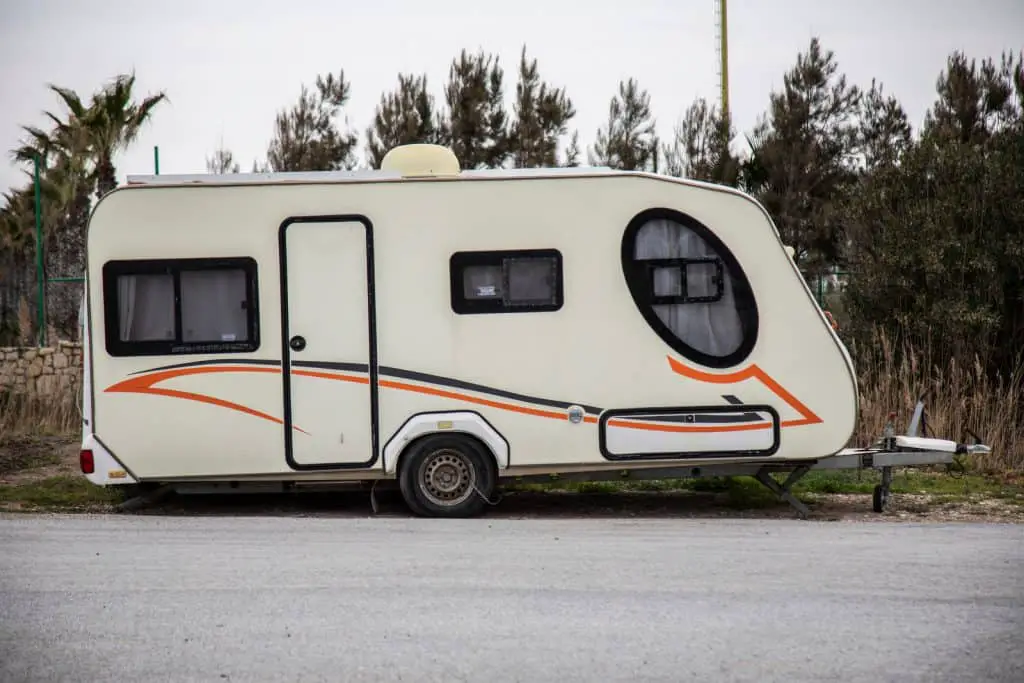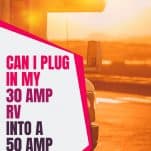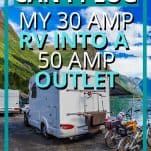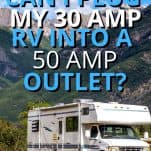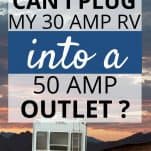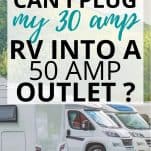
RV parks often have both 30 amp and 50 amp receptacles. However, some RV parks will only have 50 amp receptacles. If you have a 30 amp service RV, you may be concerned that you cannot find a 30 amp receptacle to plug into.
Fortunately, 30 amp RVs can plug into 50 amp outlets, and vice versa. Purchase a power adapter to plug a 30 amp service RV into a 50 amp outlet. This power adapter should be designed to withstand all weather conditions.
Here you will learn how to safely plug your 30 amp service RV into a 50 amp outlet safely. Also included are tips on how to make your 30 amp service RV more energy-efficient, so that you do not run into issues associated with tripping the circuit breaker.
The Difference Between 50 Amps and 30 Amps
Amperage (abbreviated Amps) is a measure of electric current. A 50 amp outlet will supply a larger amount of electricity over a period of time versus a 30 amp outlet. It is not uncommon for RVs to be configured for 30 amp outlets, while many campgrounds/RV resorts contain outlets configured for 50 amps.
Despite the numerical difference, 30 amp RVs can be plugged into 50 amp outlets, and vice versa. However, plugging a 30 amp RV into a 50 amp outlet will not increase the amount of power in the RV. A 30 amp RV can only handle 3,600 watts of power.
In other words, the RV will behave exactly as it normally does, regardless of whether it has been plugged into a 30 amp outlet or a 50 amp outlet.
You will still need to buy adapter equipment in order to plug your 30 amp RV into a 50 amp outlet. This is due to the fact that 30 amp and 50 amp plugs differ in design. The differences between the two plugs are easy to spot.
A 30 amp plug has three prongs:
- 120-volt hot wire
- Neutral wire
- Ground wire
A 50 amp plug has four prongs:
- 120-volt hot wire
- 120-volt hot wire
- Neutral wire
- Ground wire
50 amp RVs are able to fulfill significantly higher power demands. A 50 amp RV can receive up to 12,000 watts of power. This makes them more versatile, but that versatility is cut drastically when they are plugged into 30 amp power sources where they can only receive 3,600 watts of power. You can begin to see why so many RV parks have 50 amp outlets.
How To Connect Your 30 Amp RV To A 50 Amp Outlet
In order to connect a 30 amp RV into a 50 amp outlet, you will need to buy an adapter such as this LeisureCords 50 Amp Male to 30 Amp Female Dogbone Adapter. If you are looking for an adapter, make sure that you look for one that is weatherproof. The LeisureCords adapter referenced above has a heat-resistant PVC sleeve and a rubber-like coating.
Be Careful About How You Plug Your RV Into The Power Source
When you plug your RV into the power source, make sure that you plug the adapter into the RV before plugging into the RV park’s shore power source. If you do not perform this task in this order, then you will risk overloading the system and blowing a fuse in the RV.
Will I Need An Extension Cord With My Power Adapter?
Extension cords are not recommended for use with RVs outdoors. The Dogbone power adapter referenced in the section above has been specifically designed for use outdoors. You should park your RV close enough to the electrical supply box so that you do not need an extension cord, as is stated in this RV electrical safety pamphlet.
Will I Be Able To Use The Same Power Adapter With A Generator?
You may or may not need a different kind of adapter to power your RV with a gas generator.
- Many portable generators designed for RVs will have a 30 amp receptacle. Take, for example, this Westinghouse 3600 Watt & 4650 peak Watt Portable Generator.
- Still, other generators will have either a 15A or 20A receptacle, such as is the case with this Westinghouse 2200 Watt Generator.
- If your generator has 15A or 20A receptacles, then you can easily find power adapters for those systems as well. This 15 amp to 30 amp power adapter will do the trick.
The key point here is that you can always use a power adapter if your power source has a receptacle that doesn’t match your RV’s amperage service.
Will A 50-Amp Outlet Affect My RV’s Performance?
A 50 amp outlet will neither improve nor worsen the performance of the electrical components in your 30 amp RV. Some customers are concerned that the 50 amp service will fry the electrical components in their 30 amp RV, this is simply not true. A 30 amp RV will be able to receive 3,600 amp watts of power regardless.
There is a pretty sizable difference in the amount of power that a 50 amp and 30 amp RV are able to receive. A 50 amp RV can receive as much as 12,000 watts of power, as long as it is receiving electricity from a 50 amp outlet. Most RVs are built for 30 amps of service, and many customers have learned the hard way how easy it is to trip the circuit breaker.
A 30 amp RV limits the number of power-hungry appliances that you can actually operate at once. It will be a far cry from what you are used to at home. Fortunately, there are many simple solutions for setting up your 30 amp RV to make the most of its relatively limited power sources.
Keep Your RV Energy-Efficient With These Tips
Here are some recommendations for keeping your 30 amp RV energy efficient and from tripping the circuit breaker:
- Skirting Your RV: Some RV parks will even require you to add skirting, like this, underneath your RV. It will help make your RV more energy-efficient during times of colder weather. It will also help to reduce the chance that you trip the circuit breaker.
- Use more efficient appliances for cooking: Crock-Pots and other slow cookers use significantly less electricity than other similar cooking appliances. Propane camping stoves will also help you conserve your RV’s power sources.
- Make your RV windows energy-efficient: One of the reasons that 30 amp circuit breakers are tripped so often is due to the excessive use of heating and air conditioning. You can limit air leakage by weather stripping leaky RV windows with this adhesive insulation
- Pipe wrapping (for cold weather): You can waste a large portion of available power by trying to heat water in colder weather. You can wrap water supply pipes with an insulation like this, as long as you don’t apply the insulation too close to the water heater.
Conclusion
If you take a few precautions, there’s no reason not to can’t use a 50 amp outlet to plug in your 30 amp RV. While it’s ideal to find a 30 amp outlet, if you buy the proper adapter, your RV won’t suffer any consequences from the difference in amperage. But don’t expect any additional power to flow through your RV, either.
When selecting a power adapter, make sure it is designed to withstand all weather conditions. And take some precautions to make your RV more energy-efficient, so you don’t find yourself tripping the breaker in the middle of something important.

